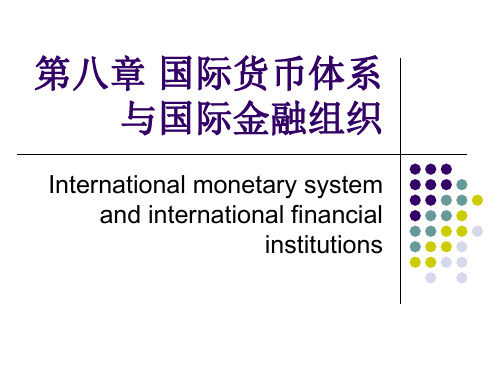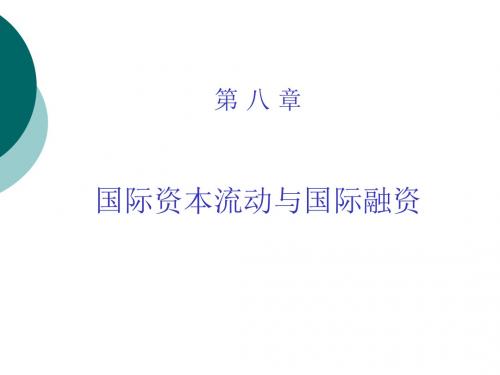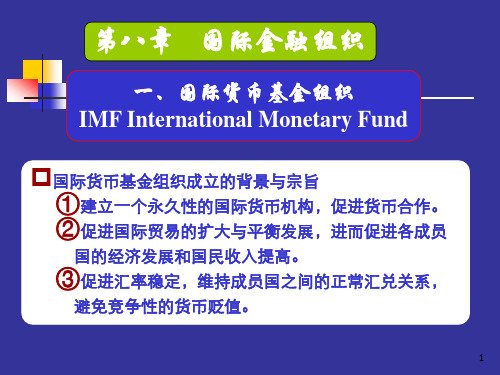International finance chapter 8 (国际金融英文版课件)
国际经融学课件(通用版)8

一、国际货币制度的概念与内容
(二)内容 汇率制度的确定 国际货币与储备资产的确定 国际收支的调节机制 各国货币的兑换性与国际结算的原则 (三)对国际货币制度的评价标准 对国际收支的调节是否有效 能否提供充足的国际清偿能力 制度的稳定性及人们对该制度的信心
二、国际货币制度的类型
以货币本位为标准对国际货币体系进行分类:
(二)国际开发协会IDA
1、宗旨: 对欠发达国家提供比IBRD条件优惠、期限较 长、负担较轻、并可部分用当地货币偿还的贷 款,以促进它们经济的发展和居民生活水平的 提高,从而补充IBRD的活动,促成IBRD目标 的实现。(软贷款)
2、组织机构 与IBRD相同
(二)国际开发协会IDA
3、资金来源: 会员国认缴的股本 会员国提供的补充资金 IBRD的拨款
二、牙买加协议后国际货币制度 的运行特征
以美元为中心的多元化的储备货币体系 以管理浮动汇率制为核心的多种汇率制度 国际收支的多种调节机制
三、对牙买加体系的评价
优点:
多元化储备体系在一定程度上缓解了“特里芬难 题”,使信心和清偿力之间的矛盾有所缓和;
浮动汇率制度能灵活地随经济状况的变动而作出调 整;
根据以上目标,缩短会员国国际收支失衡的时间,减轻 其失衡的程度。
(三)IMF的三项基本职能
汇率监督与政策协调 储备资产的创造:SDR的发行与分配 IMF的贷款业务:
贷款对象限于会员国政府 贷款主要用于会员国国际收支的调整,但也有经济
结构调整与经济改革的贷款 贷款必须同提高国际收支调节能力相结合,或必须
项目支付外汇管制的过渡期。
稀缺货币:
当一国的国际收支持续出现大量顺差时,逆差 国对该顺差国货币的需求将明显、持续增长, 并向基金组织借取该种货币,这会使这种货币 在基金组织的库存急剧下降。当库存下降到该 会员国份额的75%时,基金组织可以将该会员 国货币宣布为“稀缺货币”,并按逆差国的需 要进行限额分配,逆差国有权对稀缺货币采取 临时性兑换限制。
国际金融_International Finance 08

国际金融市场一体化
• 国际金融市场一体化是指国内和国外金融市场之 间日益紧密的联系和协调,他们相互影响,相互 促进,逐步走向统一金融市场的状态和趋势。
• 金融活动一体化 • 金融制度一体化
国际金融市场一体化标准
• 抛补利率平价 • 非抛补利率平价 • 实际利率平价 • 储蓄与投一年以下的金融工具进 行跨境交易的市场。
• 国际货币市场可以分为同业拆借市场、回购市场、 票据市场、可转让大额存单市场和国债市场。
国际资本市场
• 国际资本市场是对期限在一年或一年以上的金融 工具进行跨境交易的市场。
• 国际资本市场包括长期国际信贷市场和国际证券 市场。
机构投资者
• 广义上,用自有资金或从分散的公众手中筹集资 金专门进行投资活动的法人机构都可以被称为机 构投资者。包括商业银行、证券公司、投资公司、 保险公司和基金。
• 狭义上,机构投资者可以定义为一类特殊的金融 机构,即通过自己的经营活动从投资者手中募集 资金,代表小投资者管理他们的资产,在可接受 的风险范围内,利用这些资产进行投资获得最大 收益,主要包括养老基金、保险公司和共同基金。
主要跨国机构投资者
• 商业银行 • 证券公司 • 保险公司 • 养老基金 • 投资基金
国际投资组合
• 动机:获取更高收益、获取风险分散化收益。 • 渠道: • 在外国证券市场上直接购买外国证券 • 购买本国市场上的外国证券 • 投资共同基金
国际金融(英文版)Chapter 8 International Lending and Finan

Four proposed reforms enjoy widespread support.
First, developing countries should pursue sound macroeconomic policies, to avoid creating conditions in which overborrowing or a loss of confidence in the government’s capability could lead to a crisis.
Third, developing country governments should avoid short-term borrowing denominated in foreign currencies, to avoid crises that begin with foreign lenders abruptly demand repayment.
8.3 Resolving financial crises
Two major types of international efforts to resolve financial crises: Rescue packages Debt restructuring
《国际金融理论与实务(修订版)》第八章国际资本流动与国际融资概要

2. 经营租赁 经营租赁(Operation Lease),也称服务性租赁(Service Lease), 是—种不完全支付租赁,规定出租人除提供融资外,通常也提供特别 服务,如保险和维修等。经营租赁有下列特点。 第一,不完全支付。基本租期内,出租人只能从租金中收回设备的部 分垫付资本,需通过该项设备以后多次出租给多个承租人使用,才能 补充未收回的那部分投资和其应获利润。因此,租期较短,短于设备 有效寿命。 第二,可撤销。在租赁期满之前,承租人预先通知出租人就可中止合 同,退回设备,以租赁更先进的设备。 第三,租赁物由出租人批量采购,这些物件多为具有高度专门技术, 需要专门保养管理,技术更新快,购买金额大,且通用性较强并有较 好二手货市场,垄断性强的设备,需要有特别服务的厂商。出租人提 供维修管理、保养等专门服务并承担过时风险,负责购买保险,因此, 租金较金融租赁高得多。 第四,在经营租赁方式下,承租人账务上仅作为费用处理,而资产仍 在出租人的账簿上。这种租赁业务一般由制造厂商租赁部或专业租赁 公司经营。
(二) 短期资本流动 短期资本流动主要有以下几种类型 1. 贸易资金流动 2. 银行资金流动 3. 保值性资本流动 4. 投机性资本流动 投机者一般是利用以下几种市场行情的变动进行投机活动 (1) 利用外汇市场汇率的变动进行投机性的外汇买卖 (2) 利用利率的变动或国别利差,将资本从利率低的国家调往 利率高的国家,以取得较高的利息收益 (3) 利用国际证券市场价格的变动,调动短期外汇资金买卖不 同国家的证券,以牟取投机利润。
3. 国际贷款 (1) 政府贷款(2) 国际金融机构贷款(3) 国际银行贷 款 4. 出口信贷 (1) 出口信贷的利率,一般低于相同条件资金贷放市 场利率,利差由国家补贴。 (2) 出口信贷的发放与信贷保险紧密结合。 (3) 国家成立发放出口信贷的机构,制定政策,管理 与分配国际信贷资金,以弥补私人商业银行资金的不 足,改善本国的出口信贷条件,加强本国出口商夺取 国外销售市场的能力。 卖方信贷和买方信贷
国际金融8第八章国际金融组织ppt课件

7
SDR(Special Drawing Rights)特别提款权简介
①概念:IMF依靠国际纪律创造出来的一种储备资产,具有价值尺度、
支付手段、储藏手段的职能,而没有流通手段的职能,不能被私人 用来直接媒介国际商品的流通,不是真正的国际货币。 各成员国政
11
国际货币基金组织的贷款条件
①对象:仅限于成员国政府财政、金融部门 ②用途:弥补成员国国际收支逆差或经常项目的国际支付 ③期限:1-5年 ④利率:浮动利率、6.25%的固定使用费、0.5手续费 ⑤额度:与所缴份额成正比,每年不超过其份额的110%,3年累计
不超过份额的330%,总累计净额不超过440%
2005年12月31日,IMF“一篮子”货币在特别提款权中所占的比例 分别为美元(44%)、欧元(34%)、日元(11%)、英镑(11%),一个特别提款 权为1.42927美元。
10
SDR虽然不是真实的货币,使用时须先换成其他货币,并且 不能直接用于贸易或非贸易的支付。但是在很多国际结算领域,却 都可以看到SDR作为国际统一结算货币记价单位的身影。
①对用于生产目的的投资提供便利,以协助各成员国的复
兴与开发。
②以保证或参加私人贷款或私人投资的方法,促进私人投
资。
③用鼓励国际投资以开发成员国生产资源的方法,促进国
际贸易的长期平衡发展,并维持国际收支平衡
④在提供贷款保证时,与其他方面的国际贷款配合
16
世界银行的职能 ①组织发放长期贷款,协助成员国的经济复兴、资源开发。 ②促进和辅助私人对外贷款的投资,以保证成员国的经济
员国。
⑤第五,贷款必须专款专用,并接受世界银行的监督。世界
国际金融第八章

© 2011 Cengage Learning. All Rights Reserved. This edition is intended for use outside of the U.S. only, with content that may be different from the U.S. Edition. May not be scanned, copied, duplicated, or posted to a publicly accessible website, in whole or in partCHAPTER 17INTERNATIONAL BANKING: RESERVES, DEBT, AND RISKCHAPTER OVERVIEWThis chapter conducts a survey of the international banking system. The chapter begins by discussing how international reserves allow nations to bridge the gap between monetary receipts and payments. Deficit nations can use international reserves to buy time in order to postpone adjustment measures.The chapter then discusses the major determinants of the demand for international reserves: (1) the monetary value of international transactions and (2) the size and duration of balance-of-payments disequilibria. The need for international reserves tends to become less pronounced with floating exchange rates than with fixed exchange rates. The more efficient the international adjustment mechanism and the greater the extent of international policy coordination, the smaller the need for international reserves.The supply of international reserves consists of owned reserves and borrowed reserves. Among the major sources of reserves are foreign currencies, monetary gold stocks, special drawing rights, drawing positions at the International Monetary Fund, swap arrangements, and the General Arrangements to Borrow.When making loans, a bank faces credit risk, country risk, and currency risk. A bank can reduce its exposure to developing-nation debt through outright loan sales in the secondary market, debt buybacks, debt-for-debt swaps, and debt/equity swaps.A nation experiencing debt-servicing difficulties may cease repayments on its debt, service its debt at all costs, or reschedule its debt. Debt rescheduling has been widely used by borrowing nations in recent years.© 2011 Cengage Learning. All Rights Reserved. This edition is intended for use outside of the U.S. only, with content that may be different from the U.S. Edition. May not be scanned, copied, duplicated, or posted to a publicly accessible website, in whole or in partAfter completing the chapter, students should be able to:•Explain how international reserves allow nations to cope with balance-of-payments disequilibria. •Identify the determinants of the demand for international reserves. •Identify the major sources of international reserves. •Describe the risks that bankers face when making loans to international borrowers. •Discuss the options available to nations which experience debt-servicing difficulties. •Discuss the role of the International Monetary Fund in the world financial system.BRIEF ANSWERS TO STUDY QUESTIONS1. One drawback of a pure gold standard is that gold stocks might not grow as rapidly as international trade. Agold-exchange standard attempts to economize on gold as an international reserve by including key currencies (i.e., the U.S. dollar) as an international reserve.2.A reserve currency, such as the U.S. dollar or British pound, is a currency that trading nations are willing to hold along with other international reserve assets, such as gold.3.A country facing debt servicing problems has several options: (a) cease repayment on its debt, (b) service the debt at all cost, or (c) reschedule the debt.4. Debt equity swaps involve commercial banks selling their foreign loans to the foreign government for foreigncurrency which is then used to finance an equity investment in the foreign country. The equity investment is assumed to be a safer investment than the original loans made to the foreign borrower.5. Special drawing rights are unconditional rights to draw currencies of other countries. They were created bythe IMF to supplement the other forms of international reserve assets. The SDR's value is determined by the basket valuation technique.6. A country's debt-to-export ratio is the ratio of external debt to exports of goods and services. Changes in thisratio indicate whether a country's debt burden is rising or falling relative to its ability to pay. The debt service ratio refers to the scheduled interest and principal payments as a percent of export earnings.7. The international debt problem of the 1980s referred to the inability of some developing countries to pay backloans to Western commercial banks. The debt problem was intensified by factors including world recession, high interest rates, and the appreciation of the U.S. dollar.8. Foreign currencies constitute the most important component of the world's international reserves while specialdrawing rights constitute the least important component.9. A Eurocurrency is a deposit, denominated and payable in dollars and other foreign currencies, in banksoutside the United States. Dollar deposits located in banks outside the United States are known as Eurodollars.10. Owned reserves include monetary gold stocks, foreign currencies, and special drawing rights. Borrowedreserves include IMF drawings, swap arrangements, compensatory export financing, oil facility, and buffer stock facility.11. Since 1975 gold has been demonetized. Today, gold is considered a commodity by the InternationalMonetary Fund.12. Banks can reduce their exposure to developing country debt via several methods: (a) outright loan sales, (b)debt buybacks, (c) debt-for-debt swaps, or (d) debt/equity swaps.13. Similar to a householder's desire for cash balances, nations require international reserves to bridge the gapbetween monetary receipts and payments. Deficit nations require international reserves to finance their payments disequilibriums.14. When making international loans, bankers face the following risks: (a) credit risk, (b) country risk, and (c)currency risk.15. A country's demand for international reserves depends on the monetary value of international transactions aswell as the size and duration of payments disequilibriums.16. See Question 10.© 2011 Cengage Learning. All Rights Reserved. This edition is intended for use outside of the U.S. only, with content that may be different from the U.S. Edition. May not be scanned, copied, duplicated, or posted to a publicly accessible website, in whole or in part。
国际金融Chapter 8

ANSWER: B (1.06/1.03) – 1 = 2.9%.
ANSWER:
A
12. If nominal British interest rates are 3% and nominal U.S. interest rates are 6%, then the British pound (£) is expected to _______ by about _______%, according to the international Fisher effect (IFE). A) depreciate; 2.9 B) appreciate; 2.9 C) depreciate; 1.0 D) appreciate; 1.0 E) none of these
International Financial Management
Chapter 8 Test
1. The international Fisher effect (IFE) suggests that: A) a home currency will depreciate if the current home interest rate exceeds the current foreign interest rate. B) a home currency will appreciate if the current home interest rate exceeds the current foreign interest rate. C) a home currency will appreciate if the current home inflation rate exceeds the current foreign inflation rate. D) a home currency will depreciate if the current home inflation rate exceeds the current foreign inflation rate.
国际金融英语International Finance 课件

C. Finance (from corporate perspective), in Chinese means “公司财务”.
For a company, its assets are composed of equity (所 有者权益/自有资金)and liabilities (负债).
Assets = Equity + Liabilities
b) In the past, many things have served their turn as money, such as decorative shells, beads, stone axes, bronze, gold and silver.
c) Nowadays, for our daily point of view, money refers to notes, coins, checks, traveling checks and deposits.
机械工业出版社。 6、《经济学原理》,Gregory Mankiw, 机械工业出版社。 7、《中央银行英语教程》、《商业银行英语教程》、
《证券市场与投资银行英语教程》,李若谷、张燕铃、 和广北等,新华出版社。 8、《金融市场与机构》,Jeff Madura, 北京大学出版社。
Recommended Media for Learning
Unit 1. Money
I. Money
A. Definition of money and review of money’s history.
a) Money is defined as anything that is generally acceptable in payment for goods and services, or in discharge of debts.
00076 国际金融 第8节 汇率的种类及计算

真题讲解
从银行买卖外汇的角度,汇率可以分为( )
A.买入汇率、卖出汇率、中间汇率和现钞汇率 B.基本汇率和套算汇率 C.固定汇率与浮动汇率 D.即期汇率和远期汇率
真题讲解(201510)
一般而言,买入汇率与卖出汇率之间的关系是( )
A.主要储备货币差价大,大银行差价大 B.主要储备货币差价小,大银行差价小 C.主要储备货币差价大,大银行差价小 D.主要储备货币差价小,大银行差价大
国际金融
International Finance
第八节 汇率的种类及计算
汇率的种类及计算
01 汇 率 的 种 类 02 买 入 汇 率 、 卖 出 汇 率 、 中 间 汇 率 和 现 钞 汇 率 03 买 入 汇 率 与 卖 出 汇 率 之 间 关 系 的 特 点 04 基 本 汇 率 和 套 算 汇 率 、 固 定 汇 率 与 浮 动 汇 率 05 电 汇 汇 率 、 信 汇 汇 率 、 票 汇 汇 率 06 套 算 汇 率 的 计 算
固定汇率与浮动汇率
1.固定汇率是指一国货币与其他货币的兑换比率保持基本 固定的汇率。当汇率上涨或下跌超过一定的幅度时,中央 银行有义务进行干预,使其回到规定的范围内。在国际金 本位时期和布雷顿森林体系时期,各国普遍实行的是固定 汇率制度。 2.浮动汇率是指随外汇市场供求状况变动而波动的汇率, 该汇率可以自由浮动。20世纪70年代后期,各国纷纷将浮 动汇率制度合法化,货币当局对货币汇率波动可以不进行 干预,政府没有义务维持汇率的稳定。
买入汇率、卖出汇率、中间汇率和现钞汇率
1.买入汇率又称买入价,是指外汇银行从同业或客户手中 买进外汇时所使用的汇率。 2.卖出汇率又称卖出价,是指银行向同业或客户卖出外汇 时所使用的汇率。 3.双向报价法指外汇银行在对外报价时通常采用双向报价 法即既报买入价又报卖出价,中间用“~”或者“/”分开, 根据不同的标价法来进行具体的判断买入价和卖出价。 4.在直接标价法下,左边数值小的是买入价,右边数值大 的是卖出价;在间接标价法下,左边数值小的是卖出价, 右边数值大的是买入价。
- 1、下载文档前请自行甄别文档内容的完整性,平台不提供额外的编辑、内容补充、找答案等附加服务。
- 2、"仅部分预览"的文档,不可在线预览部分如存在完整性等问题,可反馈申请退款(可完整预览的文档不适用该条件!)。
- 3、如文档侵犯您的权益,请联系客服反馈,我们会尽快为您处理(人工客服工作时间:9:00-18:30)。
The marginal propensity to consume domestic
product (1-s-m)
The spending multiplier in a small, open economy
THE PERFORMANCE OF A NATIONAL ECONOMY
We
judge a country’s macroeconomic performance against a number of broad objectives or goals. We can usefully divide these broad goals into two categories: internal balance and external balance.
Chapter 8 HOW DOES THE OPEN MACROECONOMY WORK?
HOW DOES THE OPEN MACROECONOMY WORK?
This
chapter develops a general framework for analyzing the performance of a national economy that is open to international transactions.
The value of this multiplier is the same whether the
initial extra spending is made by the government or a surge in consumption, a rise in private investment spending, or a rise in exports.
(Y-C-G)=(E-C-G)+(X-M) or S=Id+(X-M)= Id+ If
The spending multiplier in a small, open economy
When national spending rises in an economy, this extra spending sets off a multiplier process of expansion of domestic production and income.
THE PERFORMANCE OF A NATIONAL ECONOMY
In economics, a country's current account is one of the two components of its balance of payments, the other being the capital account (sometimes called the financial account). The current account consists of the balance of trade, net primary income or factor income (earnings on foreign investments minus payments made to foreign investors) and net cash transfers, that have taken place over a given period of time.
In this section, the aggregate supply curve is supposed to be a horizontal line.
Domestic production depends on aggregate demand
Domestic production depends on aggregate demand Y = AD =C+Id+G+(X-M) National expenditures (E): E=C+Id+G Y = AD(Y) = E(Y) + X – M(Y), (Y – C – G) = (E – C – G) + (X – M), or S = Id + (X – M)
A framework for macroeconomic analysis
Our analysis of the behavior of the economy in the short run is relatively Keynesian in that the price level is not immediately responsive to aggregate demand and supply conditions in the economy. The price level is sticky or sluggish in the short run. Our view of the economy in the longer run is more classical. In the long run, the price is flexible, the price inflation depends on the growth rate of the country’s money supply. The economy tends toward full employment.
The value of this multiplier is smaller in a small open
economy than the multiplier in a closed economy.
Imports rose but exports constant for this small
Foreign-Income Repercussionry, the more its spending tends to affect other countries.
importance of close trading ties is also evident in the large effect.
THE PERFORMANCE OF A NATIONAL ECONOMY
Internal
balance refers to a ideal state of domestic economy. Full employment, or an acceptably low unemployment rate The economy’s production grows over time. Price stability, or an acceptably low inflation rate
The
A more complete framework: three markets
The Domestic Product Market
The IS curve shows all combinations of domestic product levels and interest rates for which the domestic product market is in equilibrium Y = AD = C + Id + G + (X–M), or S = Id + (X – M) The IS curve is downward sloping: lower (higher) interest rates encourage (discourage) borrowing and spending, resulting in higher (lower) real GDP Exogenous shocks that shift the IS curve
THE PERFORMANCE OF A NATIONAL ECONOMY
External balance is usually defined as the achievement of a reasonable and sustainable balance of payments with the rest of the world. Most broadly, the goal may be to achieve balance in the country’s overall balance of payments. For some purposes we focus on a somewhat narrower reading of external balance, one that focuses on the country’s current account. It is a position that is sustainable in that the value for the current account balance can readily be financed by international capital flows.
Domestic production depends on aggregate demand
The economy’s potential for producing is determined by the supply-side capabilities of the economy. Supply-side capabilities include both the factor resources that the economy has available, and intangible influences such as technology, resource quality, climate, and motivation.
